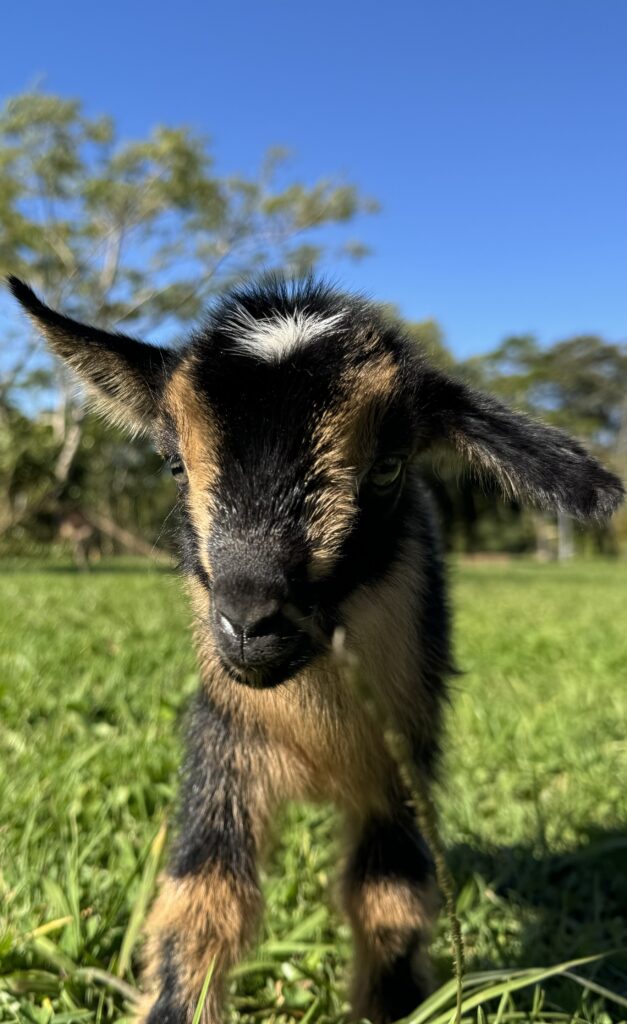Owning Goats
Nigerian Dwarf dairy goats make adorable pets, their individual personalities blending in well to a family environment. Their milk carries a higher percentage fat than cows milk and has a delicious flavour. As with owning any animal, there are a number of responsibilities that come with goat ownership. Given that these delightful creatures can live for up to 20 years, please consider the following before purchase.
Legislative Requirements
Before purchasing goats, it’s essential to understand the legislative requirements in your region. In Australia, you need a Property Identification Code (PIC) to legally keep goats. This code helps trace livestock during disease outbreaks and ensures proper animal management. Check with your local Local Lands Council/Department of Primary Industries or equivalent to obtain your PIC and stay informed about any other local regulations regarding goat ownership.
Shelter
Goats do not appreciate getting wet. They require sturdy, weatherproof shelters to protect them from extreme weather conditions. Ensure the shelter is well-ventilated and has dry bedding, such as straw or wood shavings, to keep them comfortable.
Fencing
Use strong, goat-proof fencing to keep your goats safe and contained. Fences should be at least 1.2 meters high and secure enough to
prevent escapes. Electric fencing can be an effective deterrent against predators and escapes. Baby goats are targets for foxes and wild dogs so should have secure night time accommodation until 4-5 months of age.

Diet
Goats thrive on a balanced diet of hay, fresh pasture, and formulated goat feed. Ours are fed a combination of lucerne chaff, barley, lupins and goat pellet’s with occasional seaweed supplement. Ensure they have constant access to clean water. Supplement their diet with minerals and vitamins as needed.
Toxic Plants
Be aware of plants toxic to goats, such as lantana and oleander. Keep these plants out of their grazing areas to prevent poisoning.
Vaccinations and Veterinary Care
Regular veterinary care is crucial. Vaccinations protect against diseases like tetanus and clostridial infections. Consult a veterinarian experienced with goats to create a vaccination schedule tailored to your herd.
Parasite Control
Worms are a major health concern for goats. Ensuring feed is provided off the ground and that feed containers are not contaminated by little climbing hooves are important preventive strategies. Rotational grazing and integration with other animals can also help to limit infestations. Be alert for signs of infestation in both individual animals and the herd and Perform fecal egg counts to gauge worm burden and adjust treatments accordingly. As there are limited preparations registered for worm treatment in dairy goats in Australia, it is important to engage with your local vet about local prevalence, resistance and appropriate interventions.
Hoof Care
Trim your goats’ hooves every 4-6 weeks to prevent overgrowth and related issues. Proper hoof care is vital for their mobility and overall health.
Breeding
If you plan to breed goats, ensure you understand the basics of goat reproduction and have a plan for caring for kids. Monitor pregnant does closely and provide appropriate nutrition and care.
Enrichment
Provide toys and climbing structures to keep your goats entertained and mentally stimulated. Goats enjoy exploring and playing, which helps prevent boredom and stress. Be careful not to teach your baby goat any ‘tricks’ you would not appreciate in a fully grown animal. Butting games and jumping on your back might be fun with a kid these miniature goats will grow up one day.
Record Keeping: Maintain detailed records of your goats’ health, vaccinations and treatments. This practice helps track their well-being and assists with scheduling routine and repeat care interventions.
Education: Continuously educate yourself on goat care. Join local and online goat clubs and identify reputable mentors and sources for the latest information and best practices.
By following these guidelines, you’ll create a healthy, happy environment for your goats, ensuring they thrive under your care.


